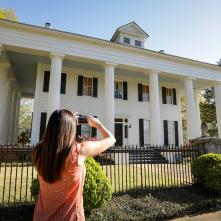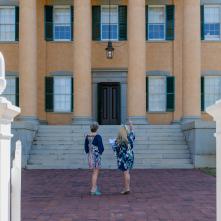Article original appeared on Lake & Sumter Style.

Photo: Tony DeSantis
New homes are wonderful, but the stories surrounding historical homes are priceless and worth preserving.
Many towns have beautiful, centuries-old homes, but none are as controversial as the ones labeled “antebellum,” especially in the South. Some people say the mansions built prior to the Civil War (1861-65) should not be preserved; however, for those who study architecture and believe in the design sensibility of that era, the homes are invaluable.
Many cities and foundations have reconciled the dark history of slave ownership with giving a new voice to all of the historical figures who lived in those homes, no matter their race or gender. And many have embraced the words of the late scientist Carl Sagan, who said, “You have to know the past to understand the present.”
While many famous antebellum homes have been on tourist maps for years, others that are lesser known have been rediscovered by history and architecture buffs. If you love seeing historical homes restored, you may want to take a road trip to visit the following.
Fit for governors
When the book “1,000 Places to See in the U.S. Before You Die” was released last year, I made a special trip to Milledgeville, Georgia, just to see Georgia’s Old Governor’s Mansion. At the time, I did not realize that the city is called “Georgia’s Antebellum Capital” because of the sheer number of existing homes that were built between the 1820s and into the Victorian era of the 1890s.

Photo: Tony DeSantis
The Old Governor’s Mansion, however, is Milledgeville’s biggest claim to architectural fame, drawing more than 15,000 visitors annually. Completed in 1839, the mansion is one of the finest examples of High Greek Revival architecture in the United States. Eight Georgia governors resided there for more than 30 years before it was abandoned during the Civil War in 1864, and the capital was moved to Atlanta. It saw a variety of uses before a $9.5 million restoration was completed in 2005.
Considered one of the most accurately restored buildings in the nation, the mansion has done an outstanding job of preserving the complete history of the building, according to Matt Davis, director.
“As a historian and a museum professional, I think we do a disservice if we do not look at [antebellum] places and try to preserve them and give them a sense of place in history,” Matt says. “I think some antebellum sites have not given the attention to all of the history that they should, and as professionals, we need to correct that.”
The mansion, Matt says, has documented every person, including slaves, who ever lived there.
Tours begin in the kitchen area with descriptions of the elaborate dinners once held in the mansion, but visitors move quickly into the steward’s room, where a slave known as Jim lived. He was the only person to have a set of keys to the mansion and when he died in his sleep, he was still clutching the keys in his hand.
Other mansion highlights include the dining room where Gen. William Tecumseh Sherman temporarily set up his headquarters, and the children’s bedroom where first daughter Mary Virginia Brown’s dolls are displayed. While Sherman troops destroyed much of the city during the Union’s devastating march to the sea in 1864, the mansion was spared. Mary’s father was Joe Emerson Brown, a Yale Law School graduate and Georgia’s 42nd governor, who fled the mansion just before Sherman’s troops arrived.
The mansion is open to the public from 10am-4pm Tuesday through Saturday and from 2-4pm Sunday. Admission is $10, adults; $7, senior citizens; and $2, students.

Bulloch Hall. Photo courtesy VisitRoswellGA
The Southern Trilogy
While not on the official Antebellum Trail, the charming city of Roswell, Georgia, just north of Atlanta, has a trio of historic homes drawing history buffs from around the world. Most significant is Bulloch Hall, where Mittie Bulloch—the mother of President Teddy Roosevelt—grew up.
Built in 1839, the Greek Revival-style mansion was the site of the spectacular wedding between Mittie and Theodore “Thee” Roosevelt Sr. in December 1853. Gwen Koehler, education director for Bulloch Hall, described Mittie as a quite theatrical and headstrong beauty.
“It is said that Mittie Bulloch may have even been the inspiration for Scarlett O’Hara in Margaret Mitchell’s ‘Gone with the Wind,’” Gwen says.
In addition to Teddy Jr., the couple had another son, Elliott, who was the father of Eleanor Roosevelt. Eleanor later married her distant cousin, Franklin D. Roosevelt, and visited Bulloch Hall as first lady.

Barrington Hall. Photo courtesy VisitRoswellGA
Barrington Hall, built in 1842, was the home of Roswell King and his son, Barrington, co-founders of the Roswell Manufacturing Co. The home is a beautiful example of Greek Revival architecture, but the garden is even more impressive, and is the only antebellum garden in metro Atlanta open to the public. In addition, cooking classes are held twice monthly on Tuesday evenings inside the restored kitchen.

Smith Plantation. Photo courtesy of VisitRoswellGA
The last home in the Southern Trilogy is the most historically accurate. The Smith Plantation, built in 1845 by Archibald Smith to escape the insects of coastal Georgia, is filled with the family’s original artifacts and possessions. Descendants sold the home to the city in 1986 on the condition that the family’s maid be allowed to live in the house for the remainder of her life. After her death, the home was opened to the public.
In addition to the main house, the property has 10 original outbuildings, including the slaves’ quarters. After stabilization efforts to the modest structure in 2015, visitors were allowed to enter. Especially poignant is an updated exhibit about the slaves who lived there, including genealogies for many of them and where they went after securing their freedom.
A Trilogy Pass to visit all three homes (Barrington, Bulloch, and Smith) is available for $18 per adult and $15 per student (ages 6-18) from the Roswell Visitors Center at 617 Atlanta St. in Roswell.
 Things To Do
Things To Do
 Events
Events
 Food & Drink
Food & Drink
 Hotels & Lodging
Hotels & Lodging
 Plan Your Trip
Plan Your Trip

